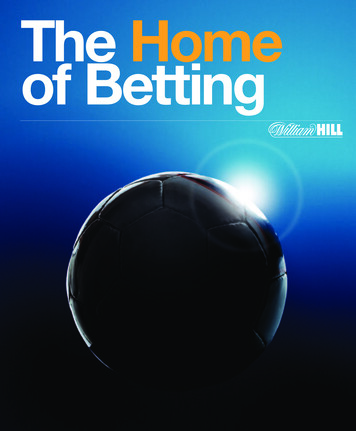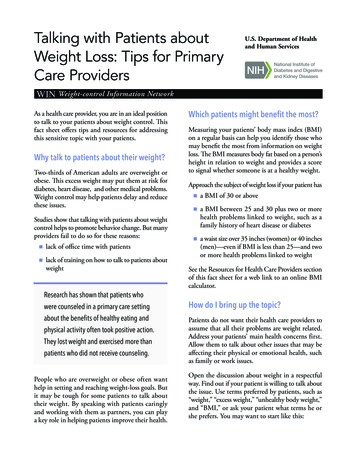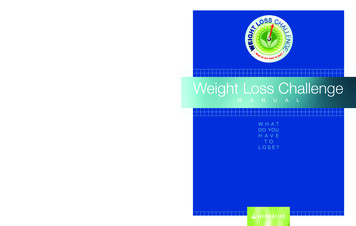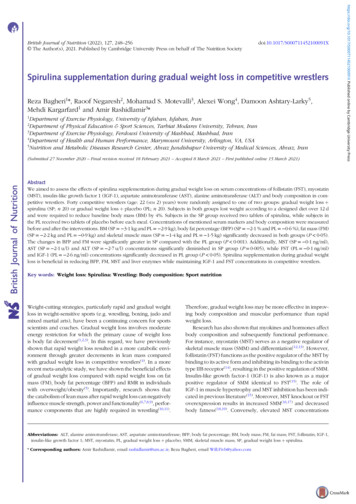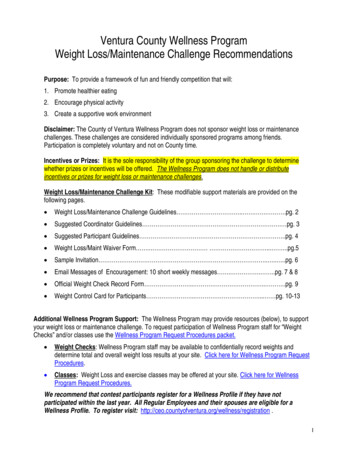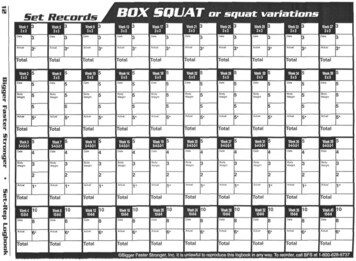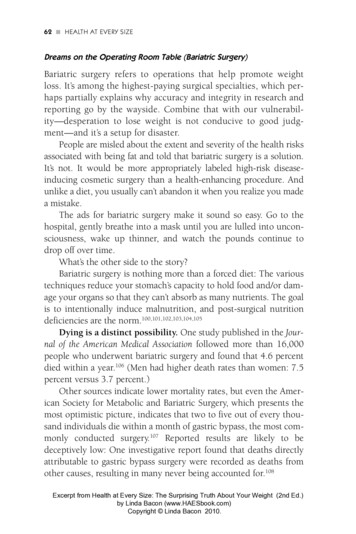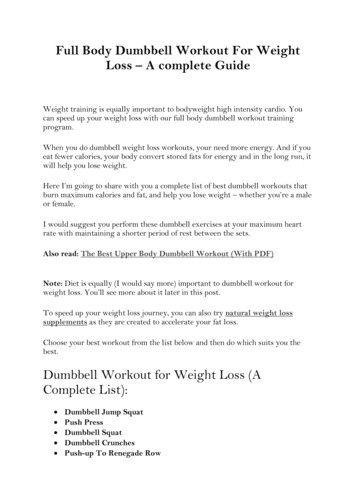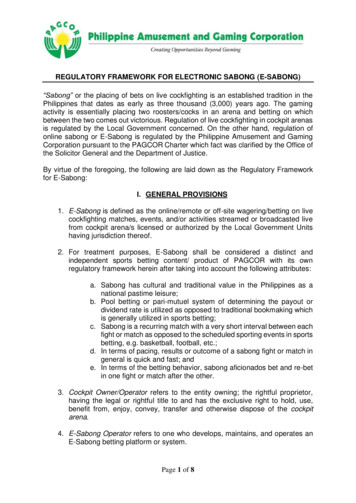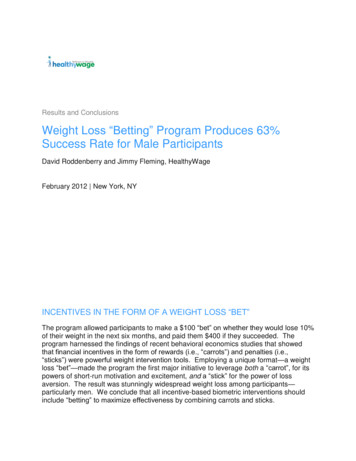
Transcription
Results and ConclusionsWeight Loss “Betting” Program Produces 63%Success Rate for Male ParticipantsDavid Roddenberry and Jimmy Fleming, HealthyWageFebruary 2012 New York, NYINCENTIVES IN THE FORM OF A WEIGHT LOSS “BET”The program allowed participants to make a 100 “bet” on whether they would lose 10%of their weight in the next six months, and paid them 400 if they succeeded. Theprogram harnessed the findings of recent behavioral economics studies that showedthat financial incentives in the form of rewards (i.e., “carrots”) and penalties (i.e.,“sticks”) were powerful weight intervention tools. Employing a unique format—a weightloss “bet”—made the program the first major initiative to leverage both a “carrot”, for itspowers of short-run motivation and excitement, and a “stick” for the power of lossaversion. The result was stunningly widespread weight loss among participants—particularly men. We conclude that all incentive-based biometric interventions shouldinclude “betting” to maximize effectiveness by combining carrots and sticks.
Executive SummaryThis report describes the results and our conclusions about the HealthyWage 10% ChallengeWeight Intervention Program (the “Program”)—a custom incentive-based weight loss “betting”program in which 66 Fortune 50 Health employees participated from August 15, 2011 throughFebruary 15, 2012. The Program allowed participants to make a 100 “bet” on whether theywould lose 10% of their weight in the next six months, and paid them 400 if they succeeded.In short, the Program led to significant weight loss for a stunning portion of participants—maleparticipants in particular. 63% of male participants lost at least 10% of their weight, andthereby successfully completed the program, as verified by a third party fitness center. Overall,29% of participants lost 10% of their weight, and thereby successfully completed theprogram. A staggering 47% of participants self-reported weight loss of at least 5%.These results are consistent with academic research that has found that financial incentives—inthe form of cash rewards (i.e., “carrots”) and cash penalties (i.e., “sticks”)—are highly effectiveweight loss tools. The Program‘s unique weight loss “betting” formula, which was designed byleading incentive-based wellness company HealthyWage, combined a carrot and a stick.Based on the results of the Program and feedback from participants, our conclusions are thatweight loss “betting” is extremely effective as (1) a targeted primary weight intervention for men,and (2) as an enhancement to other weight interventions for both men and women. We alsoconclude that biometric-based incentive programs should allow participants the opportunity to“bet” to leverage the power of a “stick” and to enhance the effectiveness of a carrot.The 10% Challenge is affordable, and can be offered at little or no cost to Fortune 50Companies. The program focuses on verified results and can be a way to incorporate regularcheck-ins or verified outcomes into a wellness program.Cleveland Clinic Health PlanThe Program is the result of collaborative innovation by a large U.S. Corporation andHealthyWage in response to numerous academic studies and industry initiatives that haveshown that behavioral economic-based interventions are extremely powerful tools for helpingpeople accomplish behaviors that are in their self-interest but which, due to self-controlproblems, they have difficulty accomplishing. Financial incentive-based programs have beenused successfully for quitting smoking, drug compliance, and weight loss. The same decisionerrors that often result in self-destructive behavior can be used instead to help people engage inbeneficial behaviors, such as weight loss.Recent studies have shown that weight loss incentives “supercharge” weight loss interventions.1The results of one widely-cited study revealed that participants in a weight intervention program1Kevin Volpp, L John, AB Troxel, L Norton, J Fassbender, G Lowenstein (2008), FinancialIncentive-based Approaches for Weight Loss: A Randomized Trial, JAMA, 300(22): 2631-2637.
who were given a financial incentive were three times more likely to achieve a defined weightloss goal than a control group that did not receive a financial incentive.Based on these studies as well as similar programs that HealthyWage2 had previouslyimplemented for other companies, HealthyWage designed an incentive program that combinedboth types of incentives—carrots and sticks—into one program consisting of a unique format: aweight loss “bet.” Participants lost their entry fee if they failed, and got their entry fee back plusa significant reward if they succeeded.Specifically, participants invested 100 for the opportunity to win 400 for losing 10% of theirweight over six months. In addition to the 100 that each participant paid, the Fortune 50Company provided 100 per participant, and HealthyWage assumed the financial exposure forpaying the 400 to all participants who won the challenge. We chose 10% weight loss becausethat amount is enough to have a meaningful clinical impact and reduction in health care costs.2In the last few years, HealthyWage has offered financial incentive-based weight loss programsto tens of thousands of Americans through over 350 large U.S. employers. HealthyWage alsooffers direct-to-consumer programs; more than 100,000 Americans have participated in one ofHealthyWage online weight loss challenges. HealthyWage’s advisory board includes leadingbehavioral economists who help it develop financial-incentive based interventions to producesignificant positive weight loss. In the last few months, HealthyWage has been profiledprominently in the New York Times and Washington Post, and mentioned in the British MedicalJournal.
MethodsThe 10% Challenge invited participants to pay 100 to win 400 for losing 10% of their weightover six months. Participants had to reach out to their wellness coach the start of the challengeand have their starting and ending weight verified by a third party health club.Participants were recruited from the body ofemployees at a Fortune 50 Company. Onlyemployees with a body mass index of at least 27were allowed to participate. Consequently, theeligible population consisted of approximately 800employees.Error! Bookmark not defined. Theeligible population was roughly 50% male and mostlyupper income.Error! Bookmark not defined.Recruiting methods were thorough and includedtargeted emails, posters in the workplace, flyers inemployee mailboxes, training healthcare coachesadvocates to explain the program, and a customwebsite for the participants to learn about theprogram and enroll. To participate, employees hadto call their wellness coach and get a registrationcode to enroll online.To the left is a screenshot of the website landingpage used to recruit participants for the Challenge aswell as copies of two of the posters put up to recruitparticipants to join.After phoning their wellness coach, participantscompleted an online registration with basicdemographic information and paid 100 via creditcard to join the challenge. Participants received anemail confirmation of payment from HealthyWagealong with instructions on how to verify their weight tostart the challenge. All participants had their startingweight verified at a third party fitness center. Afterstarting the challenge, the wellness coach followedup with participants to coach them to win thechallenge. HealthyWage reminded participantsweekly to log-in online and self-report their weight tostay on track in the challenge. At the end of theChallenge participants were emailed a reminder to get an ending weight verification.
Results and AnalysisThe 10% Challenge had meaningful, positive weight loss results. Approximately 29% ofparticipants (19 of 66) won the challenge and lost more than 10% of their weight after sixmonths. An additional four participants got an ending weight verification showing that they lostmore than 5% of their weight, meaning that 35% of the total starting population lost a verified5% or more of their weight over the six month program. One participant got an ending weightverification but did not lose weight. The remaining 62% of participants did not get an endingweight verification so we do not know whether they lost at least 5% of their weight. However,more than 80% of the total participants self-reported losing weight in the online journal with46.97% reporting at least a 5% weight loss in the online journal.10% rdVerified Weight by 3 party Health ClubSelf-reported and verified28.79%28.79%5% 1% 34.85% 34.85%46.97% 81.82%We analyze below the participant demographics that most affected the results: gender andstarting BMI. Other characteristics, such as the age of participants, did not appear to influencesuccess in the program. We do not have enough information to draw conclusions about jobtitle, income, and other similar demographics.GenderThere is a significant difference in the rate of success in the 10% Challenge by Gender—withmen remarkably more successful in the challenge than women. The table below illustrates that63.16% of male participants (or 12 of 19) won the challenge; while 14.89% of femaleparticipants (7 of 47) won the challenge.rd10% Weight loss verified by 3 partyMaleFemaleTotal63.16%14.89%28.79%The success of male participants in the 10% Challenge is exciting. No weight loss program hasreported such strong weight loss results for men. This outcome is consistent with tremendousmale weight loss in other HealthyWage incentive-based programs, and academic literature thatmen respond well to competition-based programs and programs involving a bet or challenge.The success of females in the 10% Challenge is good and consistent with industry weight lossresults. Female participants, providing feedback after the program, explained that the Programwas helpful for improving their success in other weight interventions. The women cited, amongother things, the specific weight loss timeline imposed by the Program as well as the cashincentives as leading reasons for its positive effect on the other interventions.The gender difference in the 10% Challenge can partially be explained by difference in weightloss ability between men and women and also by a different response to competitive games andchallenges. Studies show that, for a variety of physiological and psychological reasons(including that men are better predictors of whether they are likely to lose weight with a
particular program), men tend to be marginally more successful participants in weightintervention programs than women. Additionally, studies suggest that, given a program ofincentives to accomplish any task (whether health-oriented or not), men are considerably morelikely than women to prefer and perform well in competitive and challenge game environments.3Starting BMIIn addition to the gender differences, there is a significant difference in success in the challengeby starting BMI. Participants who were overweight or obese were more likely to win thechallenge and lose 10% of their weight than participants who were morbidly obese. The belowtable illustrates the proportion of participants who won the challenge by starting BMI and bygender.StartingBMI27-29.930-34.935 11.76%10.53%14.89%43.75%33.33%15.38%28.79%These results are consistent with the weight loss literature. It is easier for people who are lighterto lose weight in all weight loss programs. Participants with a lower starting BMI are more likelyto succeed because (1) they have less pounds to lose in order to achieve 10% weight loss; and(2) they are less likely to be subject to genetic, environmental and pathological influences thatinduce weight gain and inhibit weight loss.Why were they successful?Successful participants report that the 10% Challenge was an enhancement to their weight lossefforts. It helped them prioritize their health and accelerate lifestyle changes that they hadintended to make:“I loved the program and hope that my employer does it again since I learned a lot andunfortunately still qualify (for now). .Striving for this 400 prize cost me well over 2000. This is not a complaint. Long before the contest was over REI alone pocketedover 400 from me as I purchased winter exercising clothes. Erik's Bike Shop got almost 2000 after I bought my dream bike earlier this month as my reward. I kept a picture ofmy future bike on my cube wall, my work computer wallpaper, and my refrigerator athome; the latter was to remind me "do you really want that pudding cup? Is it worth 400?" It worked exceedingly well. I was already losing weight and getting healthier, I'mnow down 52 lbs in 2 years, but this program dramatically accelerated my progress andSee Gneezy, Uri, Muriel Niederle, Aldo Rustichini, “Performance in Competitive Environments:Gender Differences”, Quarterly Journal of Economics, CXVIII, August 2003, 1049 – 1074 &Niederle, Muriel, and Lise Vesterlund, “Do Women Shy away from Competition? Do MenCompete too Much?,” Quarterly Journal of Economics, August 2007, Vol. 122, No. 3: 10671101.3
helped me make some permanent changes that I hadn't considered before. I'm veryhappy I did it. Thanks!”-David DI already had a goal of losing at least 10% of my weight. Having the HW program was anextra boost. I think the cash prize did have an impact. More so it helped me achieve mygoal within a time period. I was more likely to stick to my fitness regiment knowing thatthe weigh-out period was just around the corner.”-David M“When I was really struggling to get a jump start I thought in terms of the 400. Forexample, was that piece of cake worth 400. If it wasn't, then I didn't eat it. Once I wason a roll and feeling really good and seeing success, the money became less important.I told everyone, no matter how it turned out, it was the best 100 I had ever spent.”-Carol FParticipants report that initially the “stick”—losing their 100 financial commitment—motivatedthem to lose weight and, later the “carrot” of winning the 400 prize, as well as the desire to“win” the Challenge—helped them lose weight (which is consistent with the academic literatureon the subject):“the program was very motivating to me . . . early on I would think about the 100 I justspent and that helped, then later in the program I would think about the 400 I could get,that was very motivating for me. In fact I even spent it (in my mind) a monthago.knowing I could have the prize or not and it was all up to me was very helpful andmade me accountable to myself (something just going on a diet and exercising on myown would not get me).”-Randy Zaffke“The cash prize was a great motivation for me at the start of the program. As I gotcloser to the end of the program I was less motivated by the money and more motivatedby making my goal.”-Brian Harms, Shoreview, MN“The cash prize totally incented me to stay on track with losing weight.”-Curtis Hunt, Golden Valley, MN“At the expense of sounding materialistic, yes, the money was the biggest motivationalfactor. Also, the fact that once the challenge was complete, I would be well on my wayto looking better for spring and summer, was another motivation for me. I continue towork out after the challenge indicating that it helped me make a lifestyle change for thebetter.”
-Paul GearhartOpen QuestionsThere are several open questions that could influence a future roll-out of the program: Who opted-in and decided to join the program: What differences are there betweenthose who decided to participate and those that did not? Can we learn anything aboutthe contest based on who chose—or did not choose—to participate? What is the ending weight of those who did not get a verified weigh-out? HealthyWagehas found that many participants lose weight, but do not bother to get a verified weighout if they will not win the challenge. What is the ending weight of the participants whofailed to win the challenge—and did they lose at least 5% of their weight. Would a larger than 100 upfront investment by the participant drive meaningfulbehavior change? Many of the participants who failed in the 10% Challenge haddisengaged from the help!care coaches within the first few months of the Challenge.These participants made clear they were not interested in coaching support andappeared to be indifferent to their financial commitment that they made to start thechallenge. This behavior by the participants was not rational—they could easily stillhave won the challenge. Perhaps, if participants made a larger upfront investment, theywould be more likely to be motivated to continue in the contest after facing personal setbacks in their weight loss efforts. Would a larger prize motivate morbidly obese participants to continue and besuccessful? Since the success rate varies significantly by starting weight, there is anopportunity to offer more obese participants a more attractive incentive program. If weincreased the prize amount by 50%, would these participants be more successful? Would prizes delivered more frequently make a difference with morbidly obese patients?Many morbidly obese participants disengage within a few months of starting theChallenge. If we required more frequent weigh-ins or check-ins as part of the program,would the participants be more likely to continue on and be successful?ConclusionsWe conclude that weight loss “betting” is effective as (1) a targeted primary weight interventionfor men, and (2) as an enhancement to other weight interventions for both men and women and(3) that biometric-based incentive programs should allow participants to “bet” to enhance theireffectiveness. Weight loss “betting” can be offered to Fortune 50 clients at little to no cost to theemployer and can significantly enhance other weight management programs.The 10% Challenge would be very effective as a stand-alone program for employers with asignificant population of male employees. The 63% male success rate presents an incredibleopportunity for employers to improve the weight of their population. The Challenge helps malesfocus on their health in a concrete timeline. The marginal incentive of a cash prize and theopportunity to “win” appear to have a strong impact on men.
This program seems to be most effective for women as an enhancement to other weight lossintervention programs and as a way to jumpstart weight loss in women whose weight loss hasstalled. As reported by female participants, the program increased feelings of accountabilityand motivation for women who were already participating in other programs, like WeightWatchers at Work. HealthyWage has found good results for women in team-based weight losscompetitions with large cash incentives. Perhaps, women benefit more from the social supportof a team and competition than an individual weight loss challenge. The 10% Challenge couldbe targeted to participants starting other weight loss programs—i.e. when joining online weightmanagement tools they could be invited to join the 10% Challenge or when members engagewith a wellness coach and start to make progress they could be invited to join the 10%Challenge to help the members stick with their goals.The program demonstrates that weight loss incentives can be an exceptionally effective tool forweight loss; however, incentive programs must be carefully constructed to produce meaningfulresults. “Betting” is an incentive tool that appears to engage participants in their health and canbe used to improve the effectiveness of other biometric incentive programs. Betting forcesparticipants to “opt in” to the incentive program by making a tangible commitment to their health.Betting can be offered at little to no cost to Companies as the people who do not win theprogram fund the prizes to those who are successful. Betting can enhance other incentiveprograms and is an important tool to include in all biometric incentive programs.
10% Weight loss verified by 3rd party 63.16% 14.89% 28.79% The success of male participants in the 10% Challenge is exciting. No weight loss program has reported such strong weight loss results for men. This outcome is consistent with tremendous male weight loss in other HealthyWage incentive-based programs, and academic literature that

